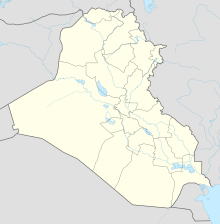Girsu
Coordinates: 31 ° 37 ' N , 46 ° 9' E
Girsu , now Tall Lawh, Tello (h) , was a Sumerian city. It was located about 28 kilometers northwest of Lagaš in the Dhi Qar Governorate in southern Iraq .
history
The city of Girsu was probably already in the 4th millennium BC. Settled . Already in the late Uruk and the Djemdet Nasr period , the city gained regional, sometimes supra-regional importance.
In the early dynastic period , after the cities had broken away from the domain of Urs , around the time of 2700 BC. Chr. To 2500 BC. BC , a state emerged from the three larger cities Girsu, Nina and the eponymous Lagaš . Girsu was the residence of the Ensis von Lagasch and at least in the late Sumerian period it was also the religious center of the state.
Girsu was practically insignificant after the New Sumerian period , but it continued for almost 2000 years until the 2nd century BC. Settled .
archeology
The first excavations were carried out from 1877 to 1900 in 11 campaigns by Gustave Ch. Ernest Chocquin de Sarzec . He found the most important group of Gudea statues to this day in Hill A ("Palais") in the palace of Adad-nadin-ahhe from the 2nd century BC. It is probably where the original installation site was found, but the portraits may have moved from the older to a younger layer in ancient times. At the same time, a large number of cuneiform tablets entered the art market through robbery . From 1903 with interruptions until 1909 Gaston Cros continued the excavations. After reports of robbery graves found in 1924, which had found statues of Gudea and the imperial and city god Ningirsu , the excavations were continued. It dug Léon Heuzey , 1929-1931 Henri de Genouillac and subsequently to 1933 André Parrot .
Remnants of a ziggurat and the Eninnu temple were uncovered (this complex is sometimes referred to as the Palace of Gudea and the connection to Eninnu is questioned). A large part of the many individual finds - many from the time of Mesalim , Ur-Nansche , Eannatum and from the New Sumerian period ( Gudea ) - are now in the Louvre in Paris . Of particular importance are over 50,000 administrative documents found in Sumerian cuneiform script from the first III period and the round sculptures found and the famous vulture statue .
Seal of Lugalanda , around 2400 BC BC, today in the Louvre
Seal of Barnamtarra , wife of Lugalanda, around 2400 BC BC, today in the Louvre
Cuneiform tablet from Urukagina (or Uruinimgina ), around 2350 BC BC, today in the Louvre
literature
- Helmut Uhlig: The Sumerians. A people at the beginning of the story. Lübbe, Bergisch Gladbach 1992. (3rd edition 2002). ISBN 3-404-64117-5 .
- Hans J. Nissen : History of the ancient Near East. Oldenbourg, Munich 1999. Oldenbourg Floor Plan of History , Vol. 25. ISBN 3-486-56373-4 .
- Gebhard Selz : Summerer and Akkader. History, society, culture. CH Beck Wissen , Munich 2005. ISBN 3-406-50874-X .
Individual evidence
- ^ Eva Strommenger , Wolfram Nagel , Christian Eder : From Gudea to Hammurapi. Fundamentals of art and history in ancient Near East Asia. Böhlau Verlag, Cologne 2005, p. 144







